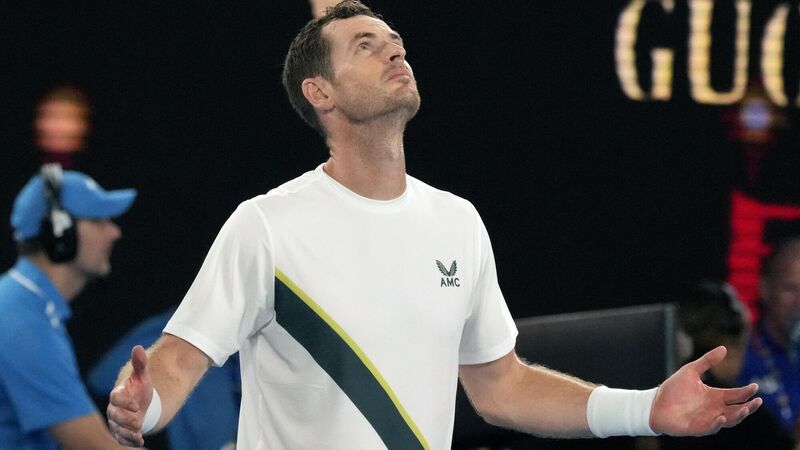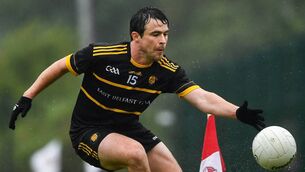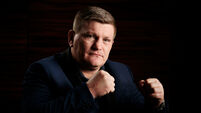Colin Sheridan: Andy Murray as a spiritual experience

LOOKING UP: Andy Murray after defeating Matteo Berrettini of Italy in their first round match at the Australian Open. Picture: AP Photo/Aaron Favila
- David Foster Wallace, Federer as Religious Experience
Saturday night under a hot-pink sky in Melbourne, Andy Murray ducked and weaved about the Margaret Court arena, moving not at all like his opponent, the manicured matador, but more like the brave bull who had been skewered, pre-show.
Every point was a novella. Every deuce a fresh take on the myth of Sisyphus. Rally after rally Murray was pushing the metaphorical boulder uphill, fully aware it was going to roll back down to the bottom. Live on television.
Each time he trudged back to retrieve it. To start all over again. Everybody knows Murray will never win a tennis major again, except perhaps the man himself. Not because of a lack of talent, certainly not because of a lack of will. He is simply unable. Yet, he goes on.
The competition seems not to be with an opponent, but with himself. His third-round battle with a baffled Roberto Bautista Agut came only a day and a half after his absurd marathon rollercoaster victory over Thanasi Kokkinakis, a five-set epic that finished at the ungodly hour of 430am.
Murray, 37, will know that nothing good ever happens after midnight. That morning he defied that rule, all logic, and probably every law of sports science to emerge triumphant. Even so, few would have bet on him to beat Bautista Agut, an accomplished performer whose route to the third round was much less tormented than Murray, who had already spent north of 10 hours on court, and just as many sets. For him to reach the second week of an Open he needs the literal luck of the draw.
On Saturday morning, it looked like his body was being held together by bailing twine. His head was another matter entirely. It was as if it had been turned inside out. He is no longer the inscrutable scot, more like a teenager with Tourettes. Each point ended with a full on conversation; sometimes with himself, sometimes with his box or the crowd or the umpire. Often with nobody. His racquet, a prop for whatever joy or frustration he was trying to convey. There was no Federer grace. No Djokovic control. No Nadal power. All that remains is the heart of a lion in the broken body of a gladiator.
If, as David Foster Wallace contended, watching Roger Federer play was an artistic experience, watching Andy Murray has become spiritual. He is not an avant garde French movie, he is Manchester by the Sea.
The thing is, unless you’re a tennis nerd, you end up watching matches like these by accident. It’s 10am on a Saturday morning. There’s jobs to be done and future Olympians to be moved from sport to sport. So, you don’t plan to watch Andy Murray. You happen upon him. You stand in sitting-room doorways, stuck, unable to move to do the thing you’re supposed to be doing because he won’t let you. Part of you wishes it’d end quicker, that’d he’d just bloody submit and lose, but the other part wants him to go on forever. You send a text, arranging an alternative collection for the wunderkinds. Sometimes the best thing to do is nothing. You move to the couch. You lean forward.
Once upon a time, Murray’s mid-match sulks were off-putting, perceived as a sign of weakness and petulance. Now, they are entirely relatable. There is nothing deliberately performative about him. He has long proven himself to be a “real one”, not defined by titles won or money made. Even so, against Agut, Murray often resembled a lad who’d overindulged on a stag weekend in Tralee. Every long point lost seaw him bent in two, leaning on his racket, as if overcome by porter. He’s done, you’d think, only for him to manufacture some magical shotmaking and prolong the agony. More than once he stood, breathless, staring at the crowd, seeming to ask with his eyes “are you not entertained?”, as if Maximus Decimus Meridius in the colosseum. There was no doubt that they were. All of us were. More than entertained. In awe, really, of his gargantuan resolve and fleeting genius.
Like Maximus, however, you know Murray can’t win. Like Maximus, you know Murray has already been hurt, lanced like the bull by the picador. He loses, but, this is no tragedy in three acts. It is a celebration. A defiant middle finger to age, to art, to order. Murray lost this battle, yes, but you somehow know now his war is already won.
After watching Patrick Mahomes lead his Kansas City Chiefs team to the Conference Championship game on Saturday night, it became a little easier to understand why 45-year-old Tom Brady has kept going as long as he has. For a few years now, Mahomes has looked like Brady’s heir apparent, despite possessing an entirely different arsenal of weapons. While Brady has been largely geriatric in his ability to move outside the pocket, Mahomes is a natural scrambler, blessed with dancing feet and uncanny ability to avoid big hits.
He also possesses a range of throws you’d swear were computer-generated. He plays football the way you think you would when you don’t know the rules. Where their talents merge is decision making and big time, clutch plays. On Saturday night, Mahomes gave us the two versions of himself; the Patrick version, and the Brady one.
On the opening drive he looked imperious, marching his team up the field with plays which included a jump pass to Travis Kelce, a sidearm throw to JuJu Schuster, before finding Kelce again as he was being thrown to the ground by an opposing defensive linesman. So far, so Mahomes. It was on his very next drive, we saw another side to him, the Brady side, as Mahomes badly injured his ankle. Forced to sit out the rest of the half, he returned, unable to run, instead hopping or limping in between snaps, even during plays. With zero mobility, his offensive line stepped up, protecting him to such an extent that he could sit in the pocket, calmly survey his option, and expertly complete his passes. All on one leg. It was a phenomenal performance in extraordinary circumstances. At least Mahomes, 27, now knows what it feels like to be 45.
Fr Micheál MacGréil died last week. He was not a figure in the sporting world, but a brilliant sociological mind and tireless advocate for the underprivileged and marginalised in Irish society. He was also a Jesuit priest, university lecturer, a retired army officer and a devout Mayo and Manchester United fan. A family friend, he resembled - to me at least as a young, impressionable man - Richard Harris’s Bull McCabe, with his snow white beard and lived-in face. To encounter him by chance on the train to Westport or on the walk down Jones Road to Croke Park was always an accidental audience with greatness. In true Jesuit fashion, he always eschewed a cup of tea when offered, opting for a full fry instead. He has more than earned his rest.
Like the Late Late Show, who presents the Sunday Game really matters to Irish people. Yesterday, RTÉ announced Jacqui Hurley as Des Cahill’s replacement on the show, as well as unveiling their supporting cast of pundits, a list which includes recently retired Lee Keegan and Sky Sports transfer Peter Canavan. Hurley is an experienced, quality broadcaster who will no doubt make the role her own, but one can’t help feeling RTÉ missed a trick in not going outside the family, adding a fresh face to a tired format. By playing it safe, it looks like we can expect more of the same.








